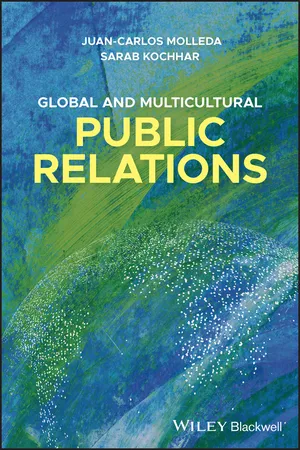
Global and Multicultural Public Relations
- English
- ePUB (mobile friendly)
- Available on iOS & Android
Global and Multicultural Public Relations
About this book
An overview of the practice of strategic global and multicultural public relations in various sectors
Global and Multicultural Public Relations offers students an expert overview of specific public relations practices, focused on strategic analyses of actual case studies and real-world examples. Emphasizing practice rather than theory, this valuable resource explores innovative communication programs that are designed to address culturally-diverse communities worldwide. The five-step strategic public relations process—formative research, planning, implementation, evaluation, and stewardship—is extensively examined and applied to a variety of scenarios, helping students understand the realty of modern public relations practice.
All aspects of public relations practice, including media relations, government relations, employee communications, and shareholder relations are covered to help students gain solid foundational knowledge. Broad in scope, this textbook identifies and describes the strategy formulation and implementation process in private, government, non-profit, and various other sectors.
Academic and trade articles, book chapters, original case studies, and new primary research offer students a realistic and sophisticated approach to global public relations. Figures, tables, photographs, and charts illustrate each topic, while highlighted learning objectives and key points, discussion questions, and framed sections on ethical considerations and best practices strengthen student comprehension.
- Employs a real-world approach to public relations principles, practices, and strategies
- Focuses on global public relations rather than outdated nation-centered models
- Fills a gap in current literature on multinational and multicultural public relations
- Explains the public relations strategies that are best suited for each sector
- Includes summary sections that contain suggested readings and supplemental online links
Designed for upper-level undergraduate and graduate students, Global and Multicultural Public Relations is an ideal textbook for courses in international public relations, global communication, public relations management, and multinational management, as well as business, political sciences, and public administration.
Frequently asked questions
- Essential is ideal for learners and professionals who enjoy exploring a wide range of subjects. Access the Essential Library with 800,000+ trusted titles and best-sellers across business, personal growth, and the humanities. Includes unlimited reading time and Standard Read Aloud voice.
- Complete: Perfect for advanced learners and researchers needing full, unrestricted access. Unlock 1.4M+ books across hundreds of subjects, including academic and specialized titles. The Complete Plan also includes advanced features like Premium Read Aloud and Research Assistant.
Please note we cannot support devices running on iOS 13 and Android 7 or earlier. Learn more about using the app.
Information
1
Introduction and Overview of Global and Multicultural Public Relations
Keywords
multilateral organizations; trade groups; professional associations; communication hubs; evolution; transition; clearinghouse; home, host, transnational, and multinational corporations; global agencies; communication conglomerates; growth
Central Themes
- Significant historical events with economic, political, and social implications have determined the evolution, growth, and sophistication of public relations in countries and regions across the world.
- Emergent technologies are dramatically speeding up the development and increasing the reach of organizations, media outlets, citizens, and consumers, facilitating the instantaneous exchange of contents from one location to multiple locations.
- Communication conglomerates, global agencies, and networks of independent agencies are major players and influencers in the public relations industry worldwide.
- Since the 1940s, European and North American professional associations have made significant contributions to modern and strategic public relations as a profession and to the career development of national and international professionals.
- All types of organizations practice global and multicultural public relations, including government and nongovernmental organizations (NGOs), multilateral organizations, multinational corporations (MNCs), and agencies.
- The complexity of public relations programs increases when organizations operate across borders, because of the existence and dynamism of home, host, and transnational stakeholders and publics.
Introduction
This embrace of international experience comes as the industry has become increasingly global. Technology makes it even easier to communicate across the world. The supply chain now stretches across continents; as more companies draw talent, materials, and resources from all corners of the world. These changes require communications pros to speak to a growing range of audiences.(Palmer 2013, p. 25)
Forces Driving the Growth of the Practice
Even within particular industries, worldwide companies have developed very different strategic and organizational responses to changes in their environment. While a few players have prospered by turning environmental turmoil to their advantage, many more are merely surviving – struggling to adjust to complex, often contradictory demands. Some large well‐established worldwide companies have been forced to take large losses or even to abandon businesses.(Bartlett and Ghoshal 2002, p. 3)
Professional Associations
| Professional association | Foundation year |
| The Netherlands Association for Public Contact, renamed first as the Association for Public Relations in the Netherlands and later as the Dutch Association of Communication | 1946 |
| Public Relations Society of America | 1947 |
| The Canadian Public Relations Society | 1948 |
| UK Institute of Public Relations, named the Chartered Institute of Public Relations after obtaining government recognition | 1948, 2005 |
| The Norwegian Public Relations Club, later named the Norwegian Public Relations Association and finally the Norwegian Communication Association | 1949, 1972, 2000 |
Table of contents
- Cover
- Table of Contents
- 1 Introduction and Overview of Global and Multicultural Public Relations
- 2 Research, Measurement, and Evaluation
- 3 Role of National Culture and Subcultures
- 4 Professionalism and Ethical Reasoning
- 5 Transnational Corporations and Global Public Relations Agencies
- 6 Nongovernmental Organizations (NGOs), Multilateral Organizations (MOs), and Activist Networks
- 7 Coordination and Control, Standardization and Localization
- 8 Cross‐national Conflict Shifting
- 9 Corporate Social Responsibility, Sustainability, and Multisector Partnerships
- 10 Employee Communication and Global Teams
- 11 Technology, Social Media, and Big Data
- 12 Public Diplomacy and Corporate Foreign Policy in Government Institutions and Agencies
- Index
- End User License Agreement